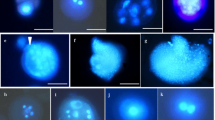Abstract
Embryogenesis from isolated microspore cultures of wheat was improved by ovary co-culture when compared to a completely defined medium. This indicates that essential factor(s) in addition to PAA or its analogs may be supplied by the ovaries. Isolated microspores cocultured with 20 ovaries of wheat on the top of semi-solid MMS3 induction medium for 21–30 days gave the best response. Both the number and quality of the embryos was significantly increased. The maximum frequencies of dividing microspores and of embryogenesis were 94% and 2.4%, respectively. Up to 2583 embryos were formed per 100 anthers of cv ‘Chris’ and between 18% and 43% of the larger embryos regenerated into green plants upon transfer. Genotype differences for both induction and embryogenesis phases were reduced using ovary co-culture. However, there was still a strong genotype influence on plant regeneration with cv ’Chris‘, with the F1 of ‘Chris’ × ‘Sinton’ displaying the highest frequencies. These results are important with respect to enhancing haploidy applications in wheat biotechnology and plant breeding.
Similar content being viewed by others
Abbreviations
- PAA :
-
Phenylacetic acid
- MMS :
-
modified MS medium
- MS :
-
Murashige and Skoog's medium 1962
- FHG :
-
Hunter's FHG medium 1988
References
Cho UH, Kasha KJ (1992) Relationship of senescence to androgenesis in barley (Hordeum vulgare L. cv Klages). J Plant Physiol 139:299–302
Crambes E, Picard E (1994) Efficient androgenetic green plant production by isolated microspore method in wheat (abstract) In: Terzi M, Cella R, Falavigna A (eds). Abs. 8th Int Cong Plant Tissue Cell Cult., Firenze, Italy, Kluwer Acad. Publ. p 203
Hu TC (1995) Isolated microspore culture of wheat (Triticum aestivum L.) and its applications. MSc thesis, University of Guelph, Guelph, Ont.
Hu TC, Ziauddin A, Simion E, Kasha KJ (1995) Isolated microspore culture of wheat (Triticum aestivum L.) in a defined medium. I. Effects of pretreatment, isolation methods and hormones. In Vitro Cell. Dev. Biol. 31:79–83
Kasha KJ (1996) Biotechnology and cereal improvement. In: Scoles G, Rossnagel B (eds) Proc 5th Int Oat Conf, 7th Int Barley Genet. Symp. Univ. Ext. Press, Univ. Saskatchewan, pp 133–140
Kasha KJ, Ziauddin A, Cho UH (1990) Haploids in cereal improvement: anther and microspore culture. In: Gustafson JP (ed) Gene manipulation in plant improvement II. Plenum Press, New York, pp 213–235
Köhler F, Wenzel G (1985) Regeneration of isolated barley microspores in conditioned media and trials to characterize the responsible factor. J Plant Physiol 121:181–191
Mejza SJ, Morgant V, DiBona DE, Wong JR (1993) Plants regeneration from isolated microspores ofTriticum aestivum L. Plant Cell Rep. 12:149–153
Mordhorst AP, Lörz H (1993) Embryogenesis and development of isolated barley (Hordeum vulgare L.) microspores are influenced by the amount and composition of nitrogen sources in culture media. J Plant Physiol 142:485–492
Murashige T, Skoog F (1962) A revised medium for rapid growth and bioassays with tobacco tissue culture. Physiol Plant 15:473–497
Reynolds TL, Kitto SL (1992) Identification of embryoid-abundant genes that are temporally expressed during pollen embryogenesis in wheat anther cultures. Plant Physiol 100:1744–1750
Stirn S, Lörz H (1995) Molecular and biochemical markers for embryogenetic potential and regenerative capacity of barley (Hordeum vulgare L.) cell cultures. Plant Sci 106:195–206
Tuvesson IKD, Ohlund RCV (1993) Plant regeneration through culture of isolated microspores ofTriticum aestivum L. Plant Cell Tissue Organ Cult 34:163–167
Ziauddin A, Simion E, Kasha KJ (1990) Improved plant regeneration from shed microspore culture in barley (Hordeum vulgare L.) cv ‘Igri’. Plant Cell Rep 9:69–72
Ziauddin A, Marsolais A, Simion E, Kasha KJ (1992) Improved plant regeneration from wheat anther and barley microspore culture using phenyl acetic acid (PAA). Plant Cell Rep 11:489–498
Author information
Authors and Affiliations
Additional information
Communicated by A. R. Gould
Rights and permissions
About this article
Cite this article
Hul, T., Kasha, K.J. Improvement of isolated microspore culture of wheat (Triticum aestivum L.) through ovary co-culture. Plant Cell Reports 16, 520–525 (1997). https://doi.org/10.1007/BF01142316
Received:
Revised:
Accepted:
Issue Date:
DOI: https://doi.org/10.1007/BF01142316




